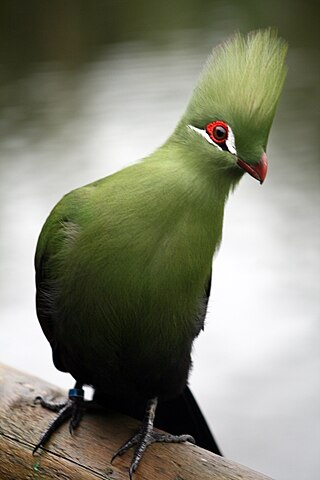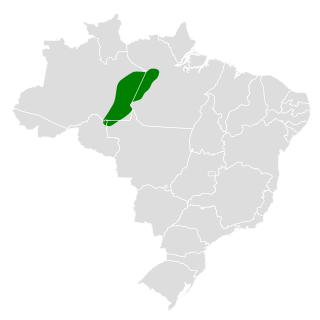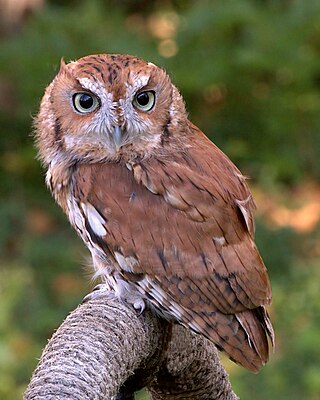Related Research Articles

The American robin is a migratory bird of the true thrush genus and Turdidae, the wider thrush family. It is named after the European robin because of its reddish-orange breast, though the two species are not closely related, with the European robin belonging to the Old World flycatcher family. The American robin is widely distributed throughout North America, wintering from southern Canada to central Mexico and along the Pacific coast.

The turacos make up the bird family Musophagidae ( "banana-eaters"), which includes plantain-eaters and go-away-birds. In southern Africa both turacos and go-away-birds are commonly known as loeries. They are semi-zygodactylous: the fourth (outer) toe can be switched back and forth. The second and third toes, which always point forward, are conjoined in some species. Musophagids often have prominent crests and long tails; the turacos are noted for peculiar and unique pigments giving them their bright green and red feathers.

The jungle myna is a myna, a member of the starling family. It is found patchily distributed across much of the mainland of the Indian Subcontinent but absent in the arid zones of India. It is easily recognized by the tuft of feathers on its forehead that form a frontal crest, a feature also found in the closely related Javan myna and the pale-bellied myna which were treated as a subspecies in the past. The eyes are pale, yellow or blue depending on the population and the base of the orange-yellow bill is dark. It has also been introduced either intentionally or accidentally into many other parts of the world including Fiji, Taiwan, the Andaman Islands, and parts of Japan. The species has also spread out on its own to some islands in the Pacific.

The grey-fronted dove is a large New World tropical dove. It is found on Trinidad and in every mainland South American country except Chile.

Ilha da Queimada Grande, more commonly referred to as Snake Island, is an island off the coast of Brazil in the Atlantic Ocean. The island became famous for its abundant snakes, hence the name "Snake Island." It is administered as part of the municipality of Itanhaém in the State of São Paulo. The island is small, with an area of only 43 hectares, and has a temperate climate. Its terrain varies from bare rock to rainforest.

The sulphur-breasted parakeet, or sulphur-breasted conure is a species of bird in subfamily Arinae of the family Psittacidae, the African and New World parrots. It is found in Brazil and Suriname. It resembles the closely related sun parakeet.

The black-fronted piping guan or jacutinga in Brazilian Portuguese is a bird in the chachalaca, guan, and curassow family Cracidae. It is found in Argentina, Brazil, and Paraguay.

The invisible rail, Wallace's rail, or drummer rail is a large flightless rail that is endemic to the island of Halmahera in Northern Maluku, Indonesia, where it inhabits impenetrable sago swamps adjacent to forests. Its plumage is predominantly dark slate-grey, and the bare skin around its eyes, the long, thick bill, and the legs are all bright red. Its call is a low drumming sound which is accompanied by wing-beating. The difficulty of seeing this shy bird in its dense habitat means that information on its behaviour is limited.

The bristled grassbird is a small passerine bird in the genus Schoenicola. Also known as the bristled grass warbler, this species is endemic to the Indian subcontinent, where it is patchily distributed in Bangladesh, India, Nepal and Pakistan. These insectivorous birds skulk in dense and tall grasslands, often in marshy areas, habitats that are threatened by human activities. Formerly considered to be sedentary, the species may be migratory, moving south and east in the Indian peninsula during winter and returning to their breeding grounds in the northern plains south of the Himalayas.

The mitred parakeet, also known as the mitred conure in aviculture, is a species of bird in subfamily Arinae of the family Psittacidae, the African and New World parrots. It is native to Argentina, Bolivia, and Peru. It has been introduced to Uruguay and is established there. There are also substantial populations in the US states of California and Florida and smaller numbers in Hawaii.

The scarlet-fronted parakeet, known in aviculture as the scarlet-fronted conure,red-fronted conure, or Wagler's conure, is a Near Threatened species of bird in subfamily Arinae of the family Psittacidae, the African and New World parrots. It is found in Colombia and Venezuela.

The painted parakeet, known as the painted conure in aviculture, is a species of bird in subfamily Arinae of the family Psittacidae, the African and New World parrots. It is found in Brazil, Colombia, French Guiana, Guyana, Panama, Suriname, and Venezuela.
The rufous-fronted antthrush is a species of bird in the family Formicariidae. It is found in Bolivia, Brazil, and Peru.

The bare-eyed antbird, occasionally known as the Santarem antbird, is a Vulnerable species of insectivorous passerine bird in subfamily Thamnophilinae of family Thamnophilidae, the "typical antbirds". It is endemic to Brazil.

The pale-faced bare-eye, sometimes known as the pale-faced antbird, is a species of bird in subfamily Thamnophilinae of family Thamnophilidae, the "typical antbirds". It is endemic to Brazil.

The lettered aracari or lettered araçari is a near-passerine bird in the toucan family Ramphastidae. It is found in Bolivia, Brazil, Colombia, Ecuador, and Peru.

The rose-fronted parakeet, known as the rose-fronted conure in aviculture, is a species of bird in the subfamily Arinae of the family Psittacidae, the African and New World parrots. It is found in Bolivia, Brazil, Ecuador, and Peru.

Screech owls are typical owls (Strigidae) belonging to the genus Megascops with 22 living species. For most of the 20th century, this genus was merged with the Old World scops owls in Otus, but nowadays it is again considered separately based on a range of behavioral, biogeographical, morphological, and DNA sequence data.

The bare-faced bulbul is a member of the bulbul family of passerine birds. It was newly described from central Laos in 2009. It is one of the very few Asian songbirds with a bald (featherless) face and is the first new species of bulbul to be described from Asia in almost a century.
Matthew Fontaine Maury Meiklejohn was an English professor of languages who held the Stevenson Chair for Italian studies at the University of Glasgow for twenty-five years. He was also a noted amateur ornithologist. It has been claimed that he was among the first "twitchers" who invented the idea of birding "life list".
References
- ↑ Meiklejohn, M. F. A. (1950). "Notes on the hoodwink (Dissumulatrix spuria)". Bird Notes. 24 (3): 89–92.
- ↑ The Bare-fronted Hoodwink (Dissimulatrix spuria). hoaxes.org
- ↑ "Recent Literature". The Auk. 68 (3): 386–405. 1951. doi: 10.2307/4081014 . JSTOR 4081014.